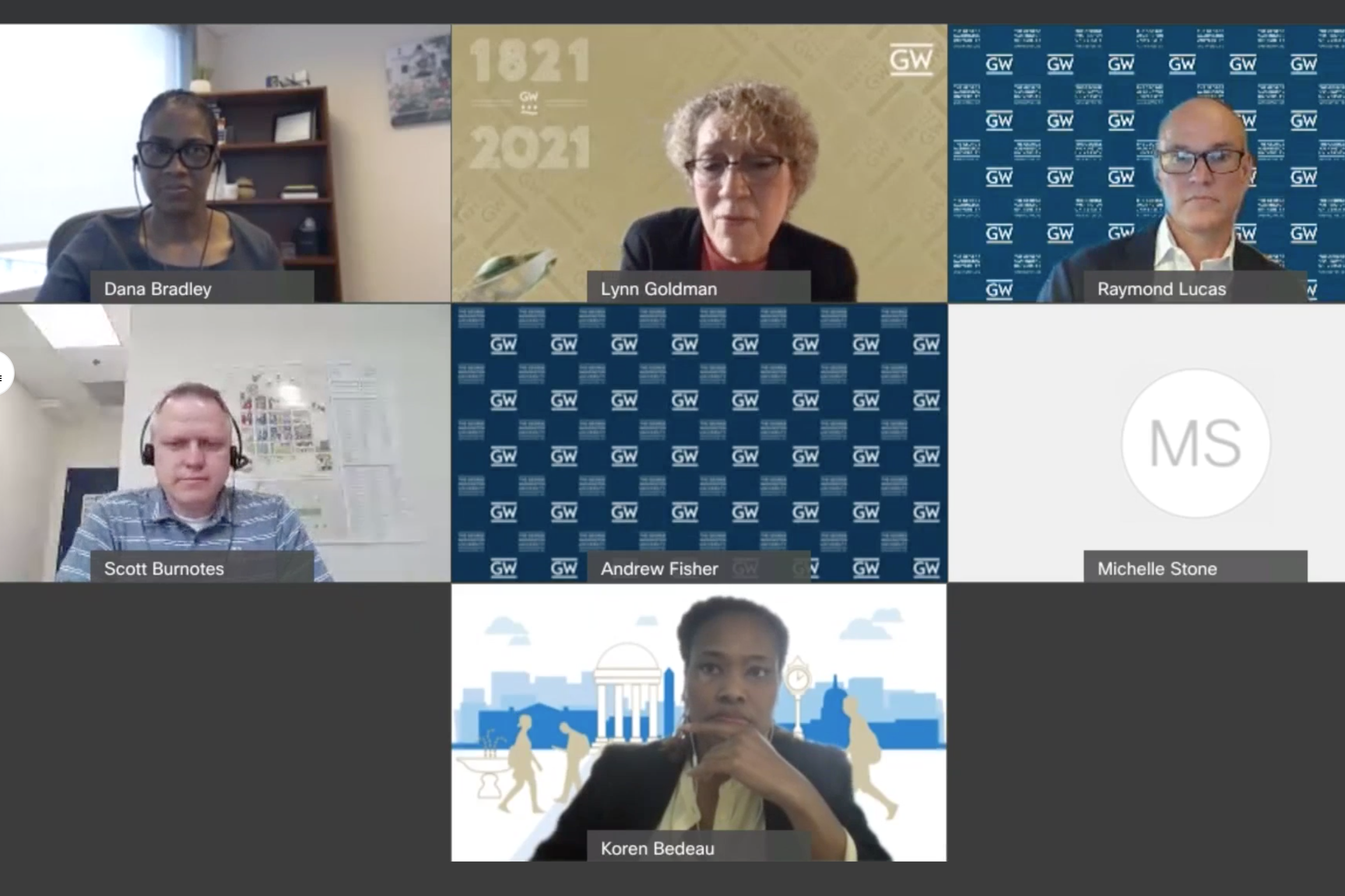All George Washington University students, faculty and staff who will be on campus for any reason are required to comply with a COVID-19 vaccine requirement by posting documentation to the university’s health portal as soon as possible, administrators said during an informational forum on GW’s vaccine policy Thursday.
At present, the Pfizer COVID-19 vaccine is available to all GW students, faculty and staff and their family members at the Foggy Bottom testing center, located in the third-floor ballroom of the Marvin Center.
“We want a normal, or as normal as possible, campus experience this fall,” said Dr. Ray Lucas, the university’s COVID-19 coordinator and an associate professor of emergency medicine in the School of Medicine and Health Sciences. “That means teaching and learning in small groups, that means teaching and learning in labs, it means playing sports, it means singing. And the safest way to accomplish that is having everyone vaccinated.”
Once a community member is fully vaccinated—receiving two doses of the Pfizer or Moderna vaccine or one dose of Johnson & Johnson—they should upload their proof of vaccination to the medical portal. Documentation will be verified by staff from the Colonial Health Center for students or GW’s Occupational Health Program for faculty and staff. Once documentation is verified, the community member will receive an email from the Campus COVID-19 Support Team (CCST) confirming verification and offering instructions for setting up a COVID-19 test. Campus access will be restored within two business hours after a vaccine-compliant person receives their first test.
Since the process requires several steps and takes time, documentation should be submitted as early as possible, Vice President for the Division of Safety and Facilities Scott Burnotes said.
“No matter when you're expected to be back on campus or when you need to be back on campus, the time to get vaccinated is now, and the time to enter that data online is as soon as you’re fully vaccinated,” Mr. Burnotes said.
Vaccination must be complete and data must be submitted by Aug. 1 in order to ensure campus access by the time the academic year begins.
Even people who will continue to spend the majority of their time working remotely should be vaccinated and have their documentation verified, said Vice President and Chief People Officer Dana Bradley. GW’s Human Resource and Management Development office has partnered with school and unit leaders to classify all staff positions as either on-site (workers whose duties have required and will continue to require a physical presence on campus), in-person (where necessary duties require in-person presence), hybrid (where work is conducted partially remotely and partially in person) or full-time remote (where a full-time staffer works from a remote location 100 percent of the time). While many positions may be classified as hybrid, few are considered full-time remote. All-hands meetings or other in-person events may include workers from every category.
“We want you to be able to have access to the campus community,” Ms. Bradley said.
Panelists emphasized the importance of a robustly vaccinated community, and explained why some COVID testing may need to continue. Testing will identify and contain the “breakthrough” infections that occur in a small percentage of vaccinated people and enable viral variants to be more effectively tracked.
“We hope to be able to capture every single virus transmitting in our population and sequence it,” said Lynn Goldman, dean of the Milken Institute School of Public Health. “We can look at the variants that have been identified and then use the guidelines that come from the WHO, the CDC and others to identify variants of concern and what we need to do to protect the community from them.”
The testing regimen also will help inform a pivot strategy quickly should COVID surge on campus or in the community.
“If the rate of COVID is exceedingly low on campus, we have all the plans to discontinue testing for vaccinated people,” Dr. Lucas said. “However, if we have a fall surge or a bunch of resistant variants in the region, we may have to continue or escalate it. We have a group of people that are monitoring this on an ongoing basis.”
Indoor mask-wearing is currently a requirement, but this will be reviewed as GW community members return to campus. Panelists pointed out that some individuals may require masks as an accommodation as they return to work or the classroom. Others may prefer to continue wearing masks and that that choice should be respected—not questioned, investigated or stigmatized. Likewise, professors and supervisors should not expect to mandate mask-wearing by those who are not explicitly required to wear them.
“We should take an approach of concern and care and allow people to do what makes them feel safe, knowing that we’re requiring all the things that we think will keep the environment safe,” said Dr. Koren Bedeau, Senior Associate Provost for Special Projects.
“We’re at a turning point in the pandemic because of immunizations and our success in being able to control transmission,” Dr. Goldman said. “I can’t be happier about the opportunity to see all of you—and to see the people in my school, in my community—in person. It’s very exciting.”



